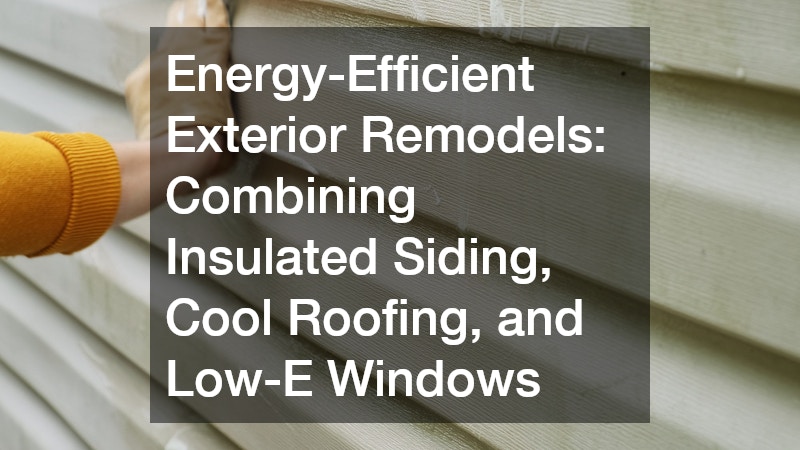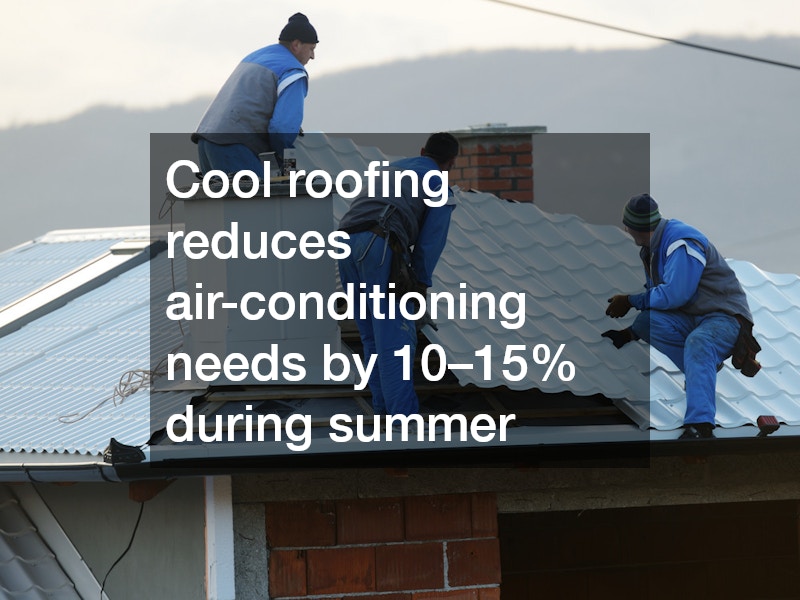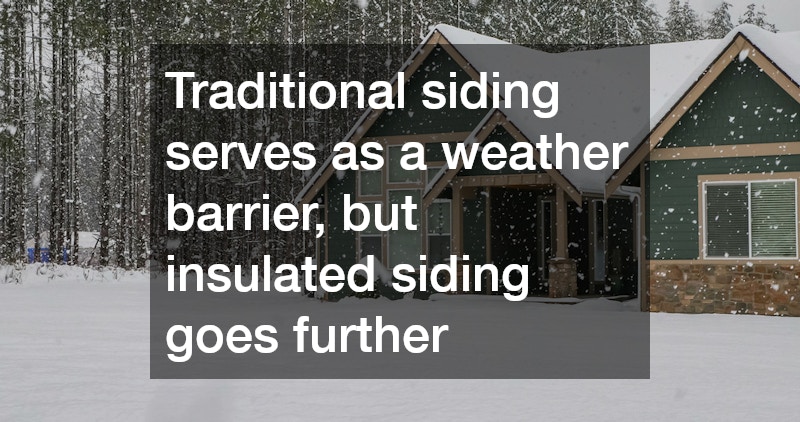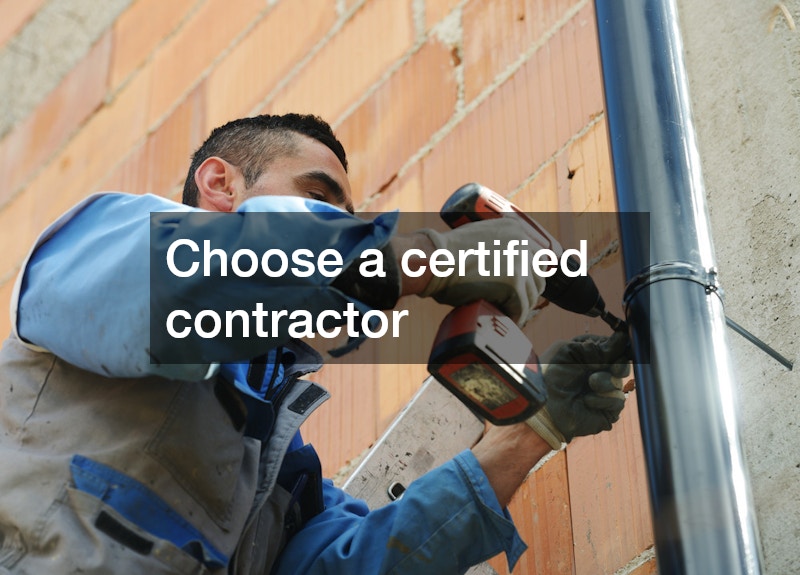-
Upgrading your home’s exterior with insulated siding, cool roofing, and Low-E windows can significantly lower heating and cooling costs—often by 20–30% annually.
-
A certified siding contractor can help choose and install insulated siding that improves wall insulation, prevents moisture damage, and enhances curb appeal at the same time.
-
Cool roofing materials, such as reflective metal panels or light-colored shingles, reduce roof surface temperature and prolong roof lifespan while improving overall comfort.
-
Low-E windows block infrared heat and UV rays, keeping interiors more comfortable year-round and protecting furniture from fading.
-
Combining all three upgrades maximizes your home’s energy efficiency and helps your HVAC system work less, leading to long-term savings.
-
Many regions offer tax incentives, rebates, and financing programs to offset the cost of energy-efficient exterior remodels.
-
Working with experienced exterior remodel specialists—including a reliable siding contractor, roofer, and window installer—ensures proper installation, warranty protection, and peak energy performance.

A home’s exterior is its first defense against heat, cold, wind, and moisture. Over time, however, older roofs, siding, and windows lose their efficiency—letting air escape, driving up energy bills, and leaving homeowners uncomfortable. Modern exterior remodels that integrate insulated siding, cool roofing, and Low-E windows can transform a property’s performance, appearance, and long-term value.
This guide explores how these three systems work together to create an energy-efficient, weather-resistant home. It also includes practical insights for homeowners working with a siding contractor or a full-service exterior remodeling company to ensure the project delivers maximum efficiency and durability.
Why Energy Efficiency Starts with the Exterior
Your home’s “thermal envelope” refers to all the layers that separate indoor living space from the outdoor environment. That includes the siding, roofing, windows, and insulation beneath them. When any of these elements are outdated or damaged, your home loses heat in winter and gains it in summer—forcing HVAC systems to work harder and increasing utility costs.
Upgrading these three components at once delivers far greater results than replacing them individually. A siding contractor or exterior remodeler experienced in integrated energy solutions can assess your home’s envelope as a whole and recommend the most cost-effective improvements.
Benefits of an upgraded energy-efficient exterior include:
-
Reduced heating and cooling costs year-round.
-
Consistent indoor temperatures with fewer drafts or hot spots.
-
Lower maintenance requirements thanks to advanced, durable materials.
-
Increased resale value and enhanced curb appeal.
-
A measurable reduction in your home’s carbon footprint.
In today’s market, more local siding contractors and roofing professionals are adopting energy-efficient materials not just for sustainability but because they perform better, last longer, and improve overall home comfort.
Insulated Siding: A Smart Investment for Comfort and Savings
Traditional siding serves as a weather barrier, but insulated siding goes further—it actually contributes to a home’s energy performance. Installed by a qualified siding contractor, insulated panels include rigid foam backing that adds continuous insulation to exterior walls.
How Insulated Siding Works
When a siding contractor installs insulated siding, they apply a layer of expanded polystyrene (EPS) or similar rigid foam behind the siding panels. This foam:
-
Adds up to R-4 of additional insulation to your home’s walls.
-
Reduces thermal bridging, which is heat loss through wall studs.
-
Creates a continuous thermal barrier, preventing air leakage and drafts.
-
Adds structural strength, allowing siding panels to resist warping or sagging over time.
For homeowners in colder or variable climates, the difference in interior comfort is often noticeable within weeks after installation.
Types and Material Options
A professional siding contractor can guide you through several insulated siding options, each with distinct benefits:
-
Insulated vinyl siding: Affordable and low-maintenance. Foam backing improves impact resistance and weather durability.
-
Insulated fiber cement siding: Combines energy performance with fire resistance and a natural, upscale appearance.
-
Engineered wood siding: Offers the warmth of real wood with added moisture and pest resistance.
-
Composite siding: Made from recycled materials, it’s eco-friendly and long-lasting.
Each material performs differently in various climates. A local siding contractor familiar with regional weather can help you choose the right balance of insulation, aesthetics, and cost.
Key Benefits of Insulated Siding
-
Improved energy efficiency: Reduces heating and cooling needs by 10–15%.
-
Enhanced comfort: Eliminates cold wall spots and drafts.
-
Sound insulation: The foam backing absorbs noise from traffic or neighbors.
-
Durability: Resists cracking, wind damage, and moisture intrusion.
-
Low maintenance: Many insulated siding products never need painting.
Cost and Return on Investment
-
Average installation costs range from $8–$14 per square foot, depending on material.
-
A certified siding contractor can estimate total project cost based on home size and local labor rates.
-
Homeowners typically recoup 70–75% of the investment upon resale.
-
Annual energy savings average $300–$500, depending on region and HVAC efficiency.
Insulated siding isn’t just about aesthetics—it’s a long-term solution that increases property value and lowers utility bills.
Cool Roofing: Reflecting Heat and Lowering Energy Bills
A cool roof is designed to reflect sunlight and emit absorbed heat, helping homeowners maintain comfortable indoor temperatures while reducing energy consumption. The roof is a home’s largest heat-absorbing surface, so upgrading it can dramatically improve overall energy performance.
What Makes a Roof “Cool”
A cool roof uses reflective coatings and light-colored surfaces to achieve high solar reflectance (the ability to reflect sunlight) and thermal emittance (the ability to release absorbed heat). Together, these properties can reduce surface temperatures by up to 50°F compared to conventional roofs.
A roofing or siding contractor trained in energy-efficient systems will evaluate your home’s orientation, local climate, and roof pitch before recommending materials that balance reflectivity, durability, and style.
Cool Roofing Material Options
-
Metal roofs with reflective coatings: Lightweight, long-lasting (40–70 years), and available in various colors that reflect solar radiation.
-
Light-colored asphalt shingles: ENERGY STAR–rated shingles reflect infrared rays, ideal for sunny regions.
-
Clay or concrete tiles: Natural insulators that maintain cooler roof decks in hot, dry climates.
-
TPO and PVC membranes: Common for low-slope roofs, offering high reflectivity and watertight performance.
Performance Benefits
-
Lower cooling costs: Reduce air-conditioning needs by 10–15% during summer months.
-
Extended roof lifespan: Reflective surfaces reduce heat-related deterioration.
-
Improved indoor comfort: Less heat transfer through ceilings and attic spaces.
-
Environmental benefit: Reduces urban heat island effect, making communities cooler.
Cost and Savings
-
Typical installation costs range from $6–$10 per square foot.
-
Annual energy savings can reach $0.20 per square foot, depending on climate.
-
Cool roofing systems generally pay for themselves within 5–7 years through reduced energy costs and extended material life.
A professional exterior remodeler or siding contractor can coordinate roofing installation alongside new siding and windows, ensuring materials and styles match while maximizing the overall thermal envelope.

Low-E Windows: Cutting Energy Loss Without Sacrificing Light
Windows play a major role in heat transfer. Low-E (low-emissivity) windows use advanced coatings to reflect infrared heat while still allowing natural daylight into your home. Upgrading to Low-E glass is one of the most effective ways to reduce heating and cooling losses.
How Low-E Coatings Work
Low-E coatings are microscopic metallic layers applied to glass surfaces. They manage heat in two directions:
-
Reflect heat indoors during winter to maintain warmth.
-
Block outdoor infrared rays in summer to prevent overheating.
-
Filter UV rays that cause fading in furniture, drapes, and flooring.
A professional installer or siding contractor who also handles window replacements can ensure these windows integrate properly with insulated siding for a continuous energy barrier.
Benefits of Low-E Windows
-
Energy savings: Up to 30% reduction in heat transfer through windows.
-
Consistent indoor comfort: Fewer cold drafts and hot spots.
-
UV protection: Blocks up to 90% of damaging ultraviolet rays.
-
Noise reduction: Dual- and triple-pane designs dampen outside sounds.
-
Condensation control: Keeps glass surfaces warmer in winter to prevent moisture buildup.
Choosing the Right Low-E Windows
Depending on regional climate, a local siding contractor or window specialist might recommend:
-
Low-E2 coatings for moderate climates, balancing solar gain and reflection.
-
Low-E3 coatings for hot regions, blocking more solar heat.
-
Gas-filled panes (argon or krypton) for enhanced insulation.
-
Frame materials: Vinyl and fiberglass for low maintenance; wood-clad for traditional aesthetics.
Costs and Incentives
-
Installation typically costs $500–$1,200 per window, depending on size and design.
-
Annual energy savings range from $100–$400 per household.
-
Many products qualify for federal or local energy tax credits.
When paired with insulated siding and cool roofing, Low-E windows complete the home’s energy-efficient envelope, ensuring minimal air leakage and optimal comfort year-round.
The Power of Combining All Three
Each upgrade—insulated siding, cool roofing, and Low-E windows—provides benefits on its own. But when installed together by a skilled siding contractor or full-service remodeling team, the results multiply dramatically.
How the Systems Work Together
-
Reduced air leakage: Tight seals between siding and window frames prevent drafts.
-
Balanced temperature control: Cool roofing and insulated walls keep indoor climates stable.
-
Consistent insulation: Combined upgrades create a thermal envelope that minimizes HVAC workload.
-
Improved moisture control: Integrated flashing and underlayment systems prevent water intrusion.
Case Study Example
A 2,000-square-foot home upgraded with all three systems achieved:
-
25% reduction in cooling costs.
-
20% reduction in winter heating costs.
-
Average indoor temperature variation reduced from 10°F to just 3°F between floors.
-
12% increase in property value within one year of completion.
A local siding contractor who collaborates with certified roofing and window specialists ensures that installation details—such as flashing, insulation continuity, and ventilation—are handled correctly to achieve this level of performance.
Budgeting, Incentives, and Financing Tips
A full exterior remodel is an investment, but careful planning and incentive programs can make it manageable.
Average Cost Breakdown
-
Insulated siding: $15,000–$25,000 for an average home.
-
Cool roofing: $10,000–$20,000 depending on slope and materials.
-
Low-E windows: $12,000–$25,000 for complete replacement.
A siding contractor experienced in whole-home exterior remodeling can provide a bundled quote that often reduces total labor costs.
Available Incentives
-
Federal energy efficiency tax credits: Up to 30% back for qualifying materials.
-
State or utility rebates: Some utilities offer rebates for ENERGY STAR windows and reflective roofing.
-
Manufacturer promotions: Many roofing and siding brands offer seasonal discounts or extended warranties for energy-efficient lines.
Financing Options
-
Home improvement loans or HELOCs: Ideal for large remodels with predictable repayment terms.
-
Energy-efficient mortgages (EEMs): Lenders consider reduced utility bills when approving larger loans.
-
Contractor financing: Many siding contractors partner with lenders to offer affordable monthly payment plans.
Choosing the Right Contractor
Finding the right siding contractor or exterior remodeler is crucial for achieving lasting performance. Installation quality directly impacts how well these materials perform over time.
Tips for selecting the right contractor:
-
Look for certifications: Choose a certified siding contractor partnered with ENERGY STAR, GAF Master Elite, or CertainTeed programs.
-
Verify experience: Contractors who handle siding, roofing, and windows can coordinate materials and timelines seamlessly.
-
Ask about warranties: Quality contractors back both materials and labor with clear guarantees.
-
Check references: Review photos of completed projects and read customer testimonials.
-
Get detailed estimates: Request breakdowns for materials, labor, permits, and disposal costs.
Working with one trusted professional instead of multiple independent contractors helps ensure consistent workmanship, cohesive design, and better warranty coverage.
Maintenance and Long-Term Care
Energy-efficient exteriors are designed for longevity, but routine care maximizes their performance.
Maintenance checklist:
-
Siding: Wash once a year with mild soap; inspect for cracks, warping, or gaps around joints; re-caulk if needed.
-
Roof: Clean gutters twice annually; inspect after major storms; reseal reflective coatings every 10–15 years.
-
Windows: Check seals annually; lubricate hinges and tracks; clean glass with a non-abrasive cleaner to preserve Low-E coatings.
A reputable siding contractor can perform annual inspections to ensure insulation and exterior seals remain intact.
An energy-efficient exterior remodel is one of the best investments a homeowner can make. By combining insulated siding, cool roofing, and Low-E windows, you create a complete system that minimizes energy loss, increases comfort, and boosts long-term value.
Working with an experienced siding contractor ensures every layer—from wall insulation to roofing reflectivity—is installed correctly and performs as intended. The result is a home that stays cooler in summer, warmer in winter, quieter year-round, and significantly cheaper to operate.
Whether you’re upgrading a single element or planning a full remodel, partnering with a knowledgeable local siding contractor can help you design a sustainable, beautiful, and energy-efficient home that stands the test of time.

